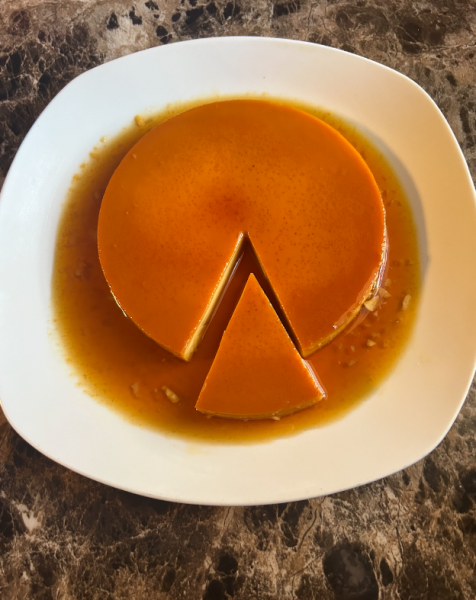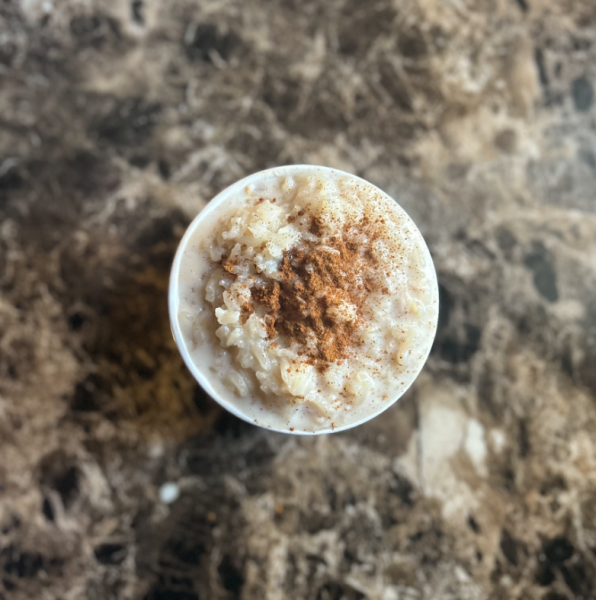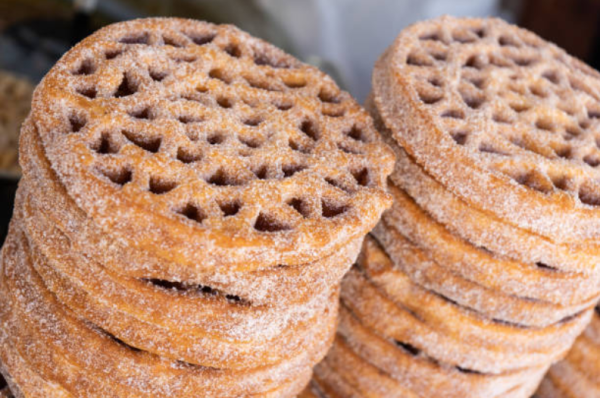In the world of Hispanic treats, three desserts hold stories as sweet as their flavors: flan, arroz con leche, and buñuelos. Picture creamy caramel, comforting rice, and crispy dough—each dish carries tales from long ago.
Flan, the velvety caramel custard treasured across Hispanic cultures, traces its lineage to ancient Rome. It was one of the first desserts in history, known as “Tyropatinam,” a concoction of milk, honey, and eggs. Before the Romans introduced this delicacy to Spain, its name was changed to “Flado” and it could be sweet, salty or eaten with fish. The name then changed once again to “Flan” once the caramel was added. After centuries of refinement and culinary fusion, flan has transformed into the creamy, caramel-coated dessert enjoyed across Latin America.

Ingredients:
- One cup of white sugar
- Three whole eggs
- Two egg yolks
- One can of evaporated milk
- One can of condensed milk
- One cup of heavy cream (or whole milk)
- One tablespoon of vanilla extract
Directions:
- Preheat the oven to 350 degrees.
- Place the sugar in a saucepan until it is melted. Remove from heat once the sugar turns into a syrup and becomes light brown.
- Pour caramel into an oven-proof pan, and move it around until it completely covers the bottom of the pan evenly.
- In a blender add the eggs, evaporated milk, condensed milk, heavy cream and vanilla extract. Blend until well combined and no lumps remain.
- Pour the custard mixture inside the pan covered in caramel and cover with aluminum foil.
- Place the pan inside a large baking pan. Add hot water to the pan until it reaches halfway up the sides.
- Place the flan in the oven for 50 minutes or until it’s firm. Remove from the oven and let it cool in the pan, one hour before running a knife between it and the baking pan.
- Once cool, place in the fridge for two hours (preferably overnight) before serving.
Level of Difficulty: 3/5
Arroz con Leche has traces leading back to Moorish Spain, where a simple rice and milk dish birthed this sweetened delight. Spanish explorers carried this comforting treat to Latin America during the colonial era. Over time, it transformed, embracing local flavors with additions of sugar, cinnamon, and regional spices. It became a staple for celebrations within Hispanic households. Nowadays, it is typically made during colder months and is best served warm. Most people choose to add raisins and chopped nuts to the rice before serving.

Ingredients:
- 4 cups of water
- 2 cups of milk
- 1 can of evaporated milk
- 1 can of condensed milk
- 3 cups of water
- ⅛ tsp salt
- 2 sticks of cinnamon
- 1 cup of long-grain white rice
- ½ cup of raisins (optional)
- 1 tablespoon of vanilla extract (optional)
- Ground cinnamon for topping (optional)
Directions:
- In a large pot, combine your rice, water, cinnamon sticks, and salt.
- Bring to a boil, then reduce heat to low and cook for 15-18 minutes.
- Drain the remaining water and stir in milk, evaporated milk, condensed milk, vanilla extract (optional), and ground cinnamon (optional). Bring to a boil, reduce heat to low, and cook for 22-30 minutes, continue stirring to avoid burning milk.
- Serve either warm or refrigerate for three hours to serve cold.
- Top it with ground cinnamon, chopped pecans, or raisins.
Level of Difficulty: 1/5
Buñuelos, the crispy fried pastries, possess a heritage reaching back to the Middle East. Eventually these round treats made their way to Moorish Spain and later became popular in Latin America after being brought over by the Spanish colonizers. Throughout the years they have been adopted with varied interpretations across regions. Buñuelos became synonymous with festive seasons. They are usually served during Christmas, New Year’s and other special occasions. Part of the reason they have become a staple in many households during the holiday season is due to their affordability to make and purchase.

Buñuelo variations:
Colombian: incorporates white cheese into the batter and is served with dulce de leche.
Mexico: served with cinnamon sugar.
Nicaragua: made from cassava flour and grated cheese.
Cuban: made in the shape of an eight. The buñuelo dough contains cassava and malanga and is served with anise caramel.
Ingredients:
- Two eggs
- One tablespoon of water
- Two tablespoons of vegetable oil
- One teaspoon of vanilla extract
- One cup of whole milk
- 1 ¼ cups of all-purpose flour
- ½ teaspoon of salt
- ½ teaspoon of baking powder
- One tablespoon of sugar
- ½ cup of white sugar for garnish
- Ground cinnamon
- Oil (for frying)
- Buñuelo tool
Directions:
- In a large bowl, mix in the following ingredients: flour, sugar, salt, baking powder, vanilla, water, oil, eggs and milk.
- Whisk the mixture until completely smooth.
- Strain the mixture to remove any lumps.
- Pour your oil into a pot and wait for it to heat up. Once the oil is hot, place the buñuelo tool in the oil for a minute or so (this is to ensure the batter will stick onto the mold).
- Remove from oil, and pat dry with paper towels to remove excess oil.
- Place the buñuelo tool in the batter, allowing the batter to stick to the end of the tool. Immediately place it in the hot oil and gently remove from the mold with a spoon.
- Fry for about 60 seconds or until golden brown.
- Mix sugar and ground cinnamon. Sprinkle the buñuelos with this mixture.
Level of Difficulty: 3/5
These desserts serve as cultural ambassadors, passing down stories and traditions through generations. Their histories speak volumes of migration, adaptation, and the resilience of culinary heritage within Hispanic communities, preserving flavors that transcend time.


































